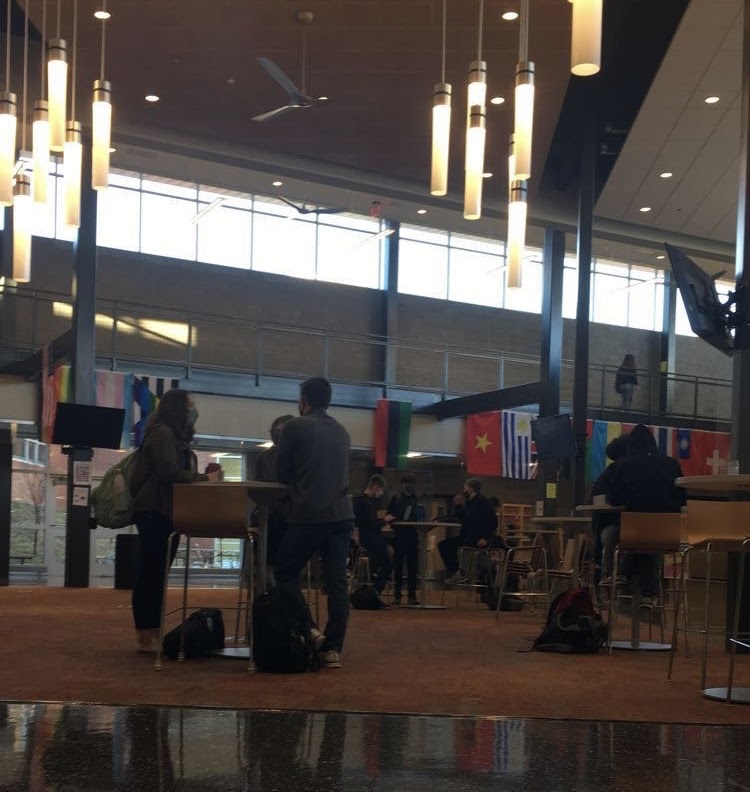COVID Cases Are Rising in State High- What Now?
Photo Courtesy of Sadie Robinson
Students at State High practice social distancing while wearing masks to keep themselves as well as others safe.
December 13, 2020
Note: This article was written prior to the announcement on Dec. 9 that SCASD schools would be fully remote until Jan. 11, and does not reflect current circumstances.
COVID-19 cases have continued to rise rapidly throughout State College. There have been constant reports recently on newfound cases for both teachers and students. Students are notified by the principal every time there is a new case within the school, and many of the hybrid learners are getting concerned about their health and safety.
“They keep announcing new cases all of the time, but always remind us not to worry because ‘we’re safe.’ But are we?” freshman Sadie Robinson said.
There were four new student cases and three new teacher cases the week of Nov. 16, and if the school decides to go back to in-person learning, there is a high chance that this number will only increase. Some say that the safest way for students to learn at the moment is for State High to go fully remote.
COVID-19 is spread by large droplets, which are expelled by coughing, sneezing, talking, etc. When someone with the virus coughs, or talks near someone who is healthy, there is an immensely high possibility of spreading it on to them, which is why State High encourages students to stay six feet apart from each other and properly wear a mask at all times.
However, many students in State High find it difficult to maintain a six feet distance during school because they find it hard to believe that their classmates have COVID. They also don’t use the safety products available to them often, which can put them at high risk of getting the virus.
“Many times, I don’t see teachers say anything to the students that aren’t social distancing, and they let them stay together, which can sometimes be concerning,” freshman Yannick Habiyaremye said. “There are also many things such as hand sanitizers around the buildings but many people don’t use them often either”.
This could be a big reason as to why cases are spreading so quickly, and because of this, State High took extra safety precautions and made the decision to go fully remote for two weeks after Thanksgiving break.
“This decision was not made lightly and reflects our district’s desire to do what is in the best interest of the entire school community’s well being,” State High nurses Mary Wagoner and Dawn Murnyack-Rowell said.
While it is not yet confirmed, many people still think that school will most likely shut down until the end of the year, and all students will be asked to return fully remote.
“I’m worried about the fact that school hasn’t completely shut down yet,” Robinson said. “I think it’s for the best because I feel like by this time, if we went with the school’s plans and guidelines [at] the beginning of the year, our school would have shut down, which can sometimes be stressful to think about.”
Some students also have mixed feelings about the school’s current situation. Although it is true that going completely remote is much safer than having to attend school 2-3 times a week, many times, students are also affected negatively by this.
“I prefer going to school in person since remote learning 24/7 can be extremely draining at times. I feel like I completely lose my motivation to do any school work if I’m asked to go to school online every day,” Habiyaremye said.
Because it can get hard for students to effectively finish their work and feel connected with the rest of the class when school is fully remote, it is not very likely that the school will completely shut down for the rest of this year, unless the cases continue to rise.
“Our mitigation measures have done an excellent job preventing the spread of COVID here at school. What we can’t control is the spread within the community at large. People not wearing masks in the community, attending social gatherings, and not following physical distancing affects us all, and ultimately affects our students and faculty/staff within the school district,” Wagoner and Murnyack-Rowell said.
In order for State High to permanently shut down, case numbers would have to decrease significantly. Because it’s difficult for students to pay complete attention in fully remote learning, the possibility of the school making this decision is not very high. In the future, there may be other remote weeks, however, it’s likely that they will be temporary, and students will have the ability to return back to school.


